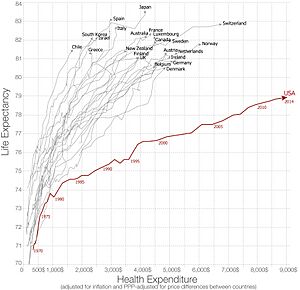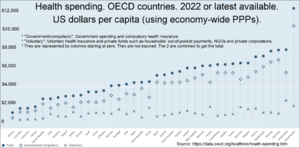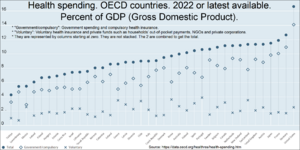Healthcare reform in the United States facts for kids
Healthcare reform in the United States is all about changing how people in America get and pay for their medical care. For a long time, people have suggested new ideas, but it's been hard to make big changes. In 2010, two important laws were passed: the Patient Protection and Affordable Care Act (often called the ACA or Obamacare) and the Health Care and Education Reconciliation Act. These laws made some of the biggest changes to healthcare in the U.S. in many years.
Even after these laws, people still suggest new ways to improve healthcare. Some ideas include a system where the government pays for most healthcare (called a single-payer system). There's even a special group called the Center for Medicare and Medicaid Innovation that tries out new ideas to see if they can make healthcare better and cheaper.
Contents
History of Big Changes to Healthcare
This section looks at some of the major steps taken at the national level to change healthcare in the United States.
- 1965: President Lyndon Johnson helped create Medicare and Medicaid.
- Medicare helps older people (senior citizens) with their hospital bills and other medical costs.
- Medicaid helps people with lower incomes get medical care. The federal government helps states pay for this program.
- 1985: The Consolidated Omnibus Budget Reconciliation Act of 1985 (COBRA) was passed. This law lets some people keep their health insurance from a past job for a while after they leave.
- 1996: The Health Insurance Portability and Accountability Act (HIPAA) became law. This act helps protect your health insurance when you change or lose jobs. It also made it so insurance companies had to cover "pre-existing conditions" (health problems you had before getting insurance) after a certain time.
- 1997: The Balanced Budget Act of 1997 created two new big programs: Medicare Part C and the State Children's Health Insurance Program (SCHIP).
- Medicare Part C gave more options for how older people could get their Medicare.
- SCHIP was set up to help provide health insurance for children in families with lower incomes.
- 2000: The Medicare, Medicaid, and SCHIP Benefits Improvement and Protection Act (BIPA) was passed. This law helped undo some of the cuts made to these programs in 1997.
- 2003: The Medicare Prescription Drug, Improvement, and Modernization Act (also called the Medicare Modernization Act) added help for older people to pay for their prescription drugs.
- 2010: The Patient Protection and Affordable Care Act (ACA), also known as Obamacare, was signed into law. This law made many big changes, including:
- Stopping insurance companies from denying coverage or charging more because of "pre-existing conditions."
- Stopping insurance companies from canceling policies when someone got sick.
- Stopping yearly or lifetime limits on how much insurance would pay.
-
- Expanding Medicaid to cover more adults with lower incomes. However, the U.S. Supreme Court later said that states could choose whether or not to expand Medicaid. Many states have now expanded it.
- Creating health insurance marketplaces. These are like online stores where people can compare and buy health insurance plans.
- Making sure insurers fully cover certain preventative services, like check-ups and shots.
- Allowing young adults to stay on their parents' health insurance plans until they turn 26.
- Creating the Center for Medicare and Medicaid Innovation to find new ways to make healthcare better and cheaper.
- 2015: The Medicare Access and CHIP Reauthorization Act of 2015 (MACRA) changed how doctors are paid for some Medicare services and continued the SCHIP program for children.
- 2017: President Donald Trump tried to change the Affordable Care Act. His plan, the American Health Care Act of 2017, passed in one part of Congress but not the other. He also signed orders that allowed insurance companies to sell cheaper, short-term plans with less coverage.
- 2021: President Joe Biden canceled the changes made by President Trump regarding short-term insurance plans.
- 2022: President Joe Biden signed the Inflation Reduction Act of 2022. This law lets Medicare negotiate some drug prices, puts a cap on how much seniors pay for prescription drugs each month, and helps make health insurance more affordable through the Affordable Care Act.
Why Healthcare Reform is Needed
People want to change healthcare because the U.S. spends a lot more money on healthcare than other rich countries. But even with all that spending, the U.S. doesn't always have better health results. This suggests that the system might not be working as well as it could.
In 2015, the U.S. spent about $3.2 trillion on healthcare, which is almost $10,000 for every person! This is much higher than other similar countries. Some reasons for these high costs include:
- High costs for running the system because there are many different insurance companies and payment rules.
- Higher prices for the same medical services and products.
- More use of expensive specialists and treatments.
- Less government control over prices.
These high costs make health insurance very expensive, which means millions of families struggle to afford it.
Cost and Availability of Insurance
It has become harder for many people to get health insurance through their jobs, and the cost of insurance has gone up a lot faster than wages. This means even people with jobs might not have enough insurance to cover their medical bills.
Studies have shown that not having enough health insurance can lead to serious problems. Some research suggests that many deaths in the U.S. each year are linked to people not having health insurance or not getting the medical care they need.
The high cost of insurance is a main reason for healthcare reform. Some people believe that healthcare should be a right for everyone, not something only available to those who can afford it. They argue that the current system, which is very focused on profit, can make healthcare too expensive and not always focused on preventing illness.
- Uninsured Rate
After the Affordable Care Act (ACA) was put in place, the number of people without health insurance in the U.S. went down a lot. This happened because:
- More people could get Medicaid.
- The government helped pay for insurance for some people.
- Insurance companies couldn't deny people with pre-existing conditions.
- People were required to have health insurance or pay a fee (though this rule was later removed).
Studies showed that many people, especially those from different racial and ethnic backgrounds, gained insurance coverage. This helped them get the medical care they needed and improved their health.
Waste and Fraud
Experts say that a big part of healthcare spending, maybe 20% to 30%, is wasted. This waste comes from things like:
- Giving patients too many tests or treatments they don't need.
- Not coordinating care between different doctors.
- The healthcare system being too complicated.
- Rules that are hard to follow.
- Fraud (people cheating the system).
A lot of money is lost to fraud each year. The government has special groups, like the Medicare Fraud Strike Force, that work to find and stop healthcare fraud.
Quality of Care
There's a lot of discussion about how good the U.S. healthcare system is compared to other countries. While there have been improvements, like the ACA making sure mental health care is covered and protecting people with pre-existing conditions, there's still work to do.
Some studies suggest that people from minority groups or with lower incomes might get lower quality care or have to pay more for it. This can make them less likely to seek medical help when they need it.
Some groups believe that a system where the government pays for healthcare would lead to better quality care for everyone and lower death rates. Others argue that a system based on competition and private companies leads to better care.
Other Ideas and New Research
Besides the current system, other ideas for healthcare reform have been suggested. These include a single-payer system and letting the federal government regulate health insurance more.
The Affordable Care Act also created ways for the government to try out new ideas through pilot projects. If these projects work well, they could be used more widely in the future.
Single-Payer Health Care
A single-payer system means that one main organization, usually the government, pays for most healthcare for everyone. People who support this idea say it could save a lot of money by:
- Focusing on preventing illnesses, which can be cheaper than treating them later.
- Getting rid of the costs of dealing with many different insurance companies.
- Making sure everyone gets care early, like for cancer, when it's easier and cheaper to treat.
Some studies suggest that if the U.S. had a universal healthcare system, it could save hundreds of billions of dollars each year and improve people's health.
Public Option
A "public option" is a government-run health insurance plan that would compete with private insurance companies. The idea is that this would give people more choices and help lower costs because the public plan would be cheaper. Some lawmakers have suggested adding a public option to the Affordable Care Act.
Balancing Doctor Supply and Demand
The government plays a role in how many doctors are trained in the U.S. By changing how doctors are paid and how many are trained, it might be possible to make healthcare more affordable and available to everyone.
Bundled Payments
Currently, doctors and hospitals are often paid for each service they provide (called "fee-for-service"). This means they get paid for every test, surgery, or visit. Some people argue this encourages more tests and procedures, even if they aren't always needed.
A new idea being tested is "bundled payments." This means doctors and hospitals in an area would get a set amount of money for a patient's care, no matter how many services are provided. The goal is to encourage them to focus on what truly helps the patient get better, at a lower cost. If this works for government programs like Medicare, private insurance companies might start using it too.
Centers for Medicare and Medicaid Innovation
The Centers for Medicare and Medicaid Services (CMS) has a special group called the Center for Medicare and Medicaid Innovation (CMMI). This group tries out new programs to improve health and lower costs.
One big area they focus on is "social determinants of health." These are things outside of medical care that affect a person's health, like where they live, if they have enough food, or if they can get transportation. CMMI programs try to connect people with community services that can help with these needs. For example, they might help people find stable housing or get rides to doctor appointments.
Transportation
Many people miss doctor appointments because they don't have a way to get there. This can lead to worse health and higher costs later on. Some hospitals and health systems are now working with ride-sharing companies like Uber and Lyft to help patients get to their appointments. This can save money in the long run and help people get the care they need.
Housing
Studies have shown that people who are homeless often use emergency rooms a lot and have very high healthcare costs. Some hospitals are partnering with groups that help homeless people find stable housing. When people have a safe place to live, their health often improves, and their healthcare costs go down significantly.
Malnutrition
Not getting enough good food (malnutrition) can make people sicker and lead to longer hospital stays. Some health programs are creating initiatives to help patients with their nutrition. These programs have shown that helping people eat better can lead to shorter hospital stays and lower readmission rates, saving money and improving health.
Trump Administration Efforts
In 2016, Donald Trump became president, promising to "repeal and replace" the Affordable Care Act. His plan, the American Health Care Act, passed in the House of Representatives but did not become law. If it had, it would have changed how insurance works and likely left many more Americans without health insurance.
See also
- Broccoli argument
- Comparison of the healthcare systems in Canada and the United States
- Health in the United States
- Health insurance
- Health Advocate
- Health care reform
- Health care reforms proposed during the Obama administration
- Health care system § International comparisons
- Health economics
- Health policy
- List of healthcare reform advocacy groups in the United States
- McCarran–Ferguson Act
- Medicare Sustainable Growth Rate





